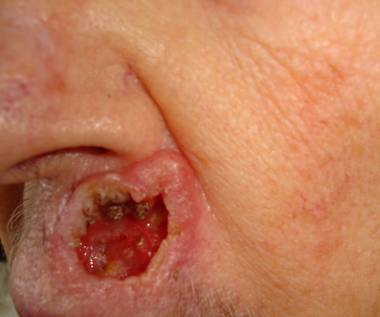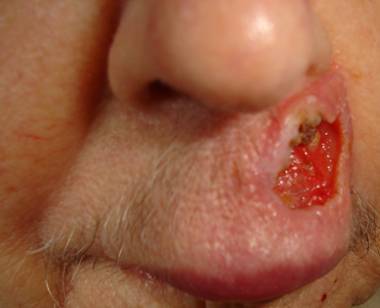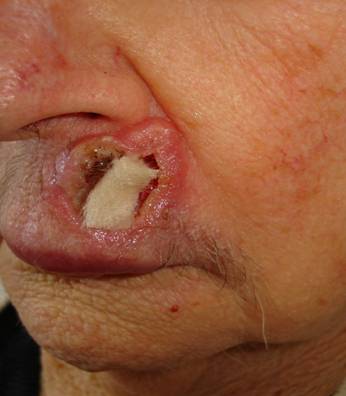Wound care for a facial ulcer; a case study.
Introduction
Wound care for facial ulcers can be challenging. The site of the ulcer; appearance; social factors; pain control; availability of wound dressings; amount of exudates and patient tolerance, all impact on the choice and combination of dressings.
Ulcers on the face are often very difficult to dress for several reasons:
- Patients don’t want to see the ulcer;
- They want the ulcer to be ‘hidden’;
- At the same time they want to look reasonable for their family & visitors;
- Discrete dressings are the obvious choice…but what?;
- It is difficult to disguise ulcers as they get larger and deeper;
- Ulcers may be extremely painful;
- Ulcers may bleed;
- There may be exudates that require thick absorbent dressings;
- Bulky dressings can interfere with vision and eating;
- Even small dressings can interfere with eating and drinking;
- Dressings may become contaminated with food thus requiring more frequent changes.
This case study serves to give healthcare workers and / or families, some ideas that may be helpful; nothing is set in stone. There is not one particular wound dressing for a facial ulcer and whatever combination of dressings you do choose please remember that pain control is an absolute priority.
Case Study
Ms. M. L., an elderly patient, has a deep, painful, malignant ulcer of the left top lip. (Photo 1) The ulcer showed evidence not only of destruction of surface tissue but it had almost eroded through the lip. It was not possible to determine the extent of the erosion because she would not allow examination of the underside of the lip.

Photo 1 Ulcer top left lip just under the left nostril.
Ms. M. L’s. pain was well managed by her general practitioner in consultation with a pain management team. Analgesia included topical morphine gel into the ulcer crater. This seemed to give great relief.

Photo 2 Hairs on the top lip
Photos’ 1 and 2 show the ulcer as well as numerous hairs on the top lip. The hairs made the choice of dressings / tape to secure dressings, difficult and shaving or clipping the hair was not an option.
Objective of wound care
- There was no chance of this ulcer ever healing so the main objectives were to:
- Reduce the ulcer pain;
- Fill the ulcer crater with a primary dressing that would ‘take up space,’ cover nerve endings, absorb exudates and not ‘stick’;
- Cover the ulcer and secure the primary dressing with a non-traumatic dressing i.e. a dressing that would not pull the hairs out of the skin on removal;
- Make sure the dressing stayed in place and did not interfere with eating and drinking;
- Ensure that as few dressing changes as possible would be required.
What did we do?
Fortunately the wound bed did not require cleaning. Even if it had it was unlikely that Ms. M.L. would have allowed any nurse to touch the ulcer. The lips and chin sometimes required a gentle wipe to remove dried exudates and / or food.
Morphine gel was put into the ulcer then a small piece of Aquacel was ‘dropped in’ to take up about 80% of the ulcer. (Photo 3) There was no packing or pushing to get it in.

Photo 3 Aquacel in the ulcer
Aquacel is a primary wound dressing made from sodium carboxymethylcellulose.
The dressing absorbs and interacts with wound exudates to form a soft, hydrophilic, gas-permeable gel that traps bacteria and conforms to the contours of the wound.
http://www.dressings.org/Dressings/aquacel.html

Photo 4 Top lip covered with Mepilex Lite
We then covered the top lip with Mepilex Lite, (Photo 4) a conformable absorbent self-adhesive dressing which consists of a thin flexible sheet of absorbent hydrophilic polyurethane foam. The wound contact surface of the dressing is coated with a soft silicone adhesive layer which adheres to the peri-wound skin, retaining the Aquacel dressing in position.
http://www.dressings.org/Dressings/mepilex-lite.html
Did it work?
Aquacel was a perfect primary dressing as it was able to be ‘dropped into’ the cavity without touching the ulcer. Equally I believe an alginate would have been perfectly suitable.
The need to cover nerve endings, reduce pain and fill the deep cavity wound without ‘packing’ was necessary and quite successful. We followed manufacturer’s recommendations to fill about 80% of the ulcer to accommodate swelling from exudates. Aquacel was held in place with Mepilex Lite a secondary dressing.
Mepilex Lite was perfect for this lady’s frail, compromised skin. It hid an unsightly, embarrassing ulcer and did not interfere too much with eating and drinking. It was fairly easy and atraumatic to remove, unlike strong adhesive dressings and tapes which would no doubt have pulled the hairs out of Ms. M. L.’s skin, causing unnecessary pain.
There is no conflict of interest. I have not been paid by any company to write this article, nor am I paid to promote these products in any healthcare facility.
Some details have been altered slightly for patient confidentiality.
I am not qualified to comment on the pain management regime.


I’m extremely inspired with your writing talents and also with the structure on your blog. Is this a paid topic or did you modify it yourself? Either way keep up the nice high quality writing, it’s rare to look
a nice weblog like this one these days..
Superb blog! Do you have any hints for aspiring writers?
I’m hoping to start my own website soon but I’m a little lost on everything.
Would you advise starting with a free platform like WordPress or go for a paid option?
There are so many options out there that I’m completely overwhelmed .. Any tips? Bless you!